Anorexia 厌食症
神经性厌食症的诊断标准

神经性厌食症的诊断标准神经性厌食症(Anorexia Nervosa)是一种以拒绝摄食、对体重过分关注和恐惧、自我价值感过度依赖体重和外貌等为特征的精神障碍。
神经性厌食症的诊断需要依据一系列的标准和指南,以确保对患者的准确诊断和有效治疗。
首先,根据《精神障碍诊断与统计手册第五版(DSM-5)》,神经性厌食症的诊断标准包括以下几个方面,首先是拒绝维持正常体重的急迫性,表现为明显的体重减轻;其次是对体重和体形过分关注,常常伴有对自己体重和体形的扭曲认知;再者是对摄入食物的严格限制,甚至拒绝进食;最后是对体重增加的恐惧和焦虑,以及对体重控制的过度依赖。
这些标准是诊断神经性厌食症的重要依据,医生需要根据患者的具体情况进行综合评估。
除了DSM-5的诊断标准,国际上也有其他一些诊断指南,如世界卫生组织的《国际疾病分类(ICD-10)》。
ICD-10对神经性厌食症的诊断标准与DSM-5有些许不同,但总体上也包括对体重、体形的过分关注和限制性进食的特征。
这些不同的诊断标准为医生提供了多样化的诊断工具,有助于更准确地诊断患者的病情。
在进行神经性厌食症的诊断时,医生还需要排除其他可能导致类似症状的疾病,如甲状腺功能亢进、癌症、消化系统疾病等。
这些疾病可能会导致体重减轻和进食困难,与神经性厌食症产生混淆,因此排除这些疾病对于准确诊断神经性厌食症至关重要。
除了体征和症状的评估,医生还需要了解患者的心理状况和家庭背景,以全面了解患者的病情。
神经性厌食症往往伴随着焦虑、抑郁、自卑等心理问题,而家庭环境的影响也可能对患者的病情产生重要影响。
因此,医生需要进行全面的评估,以便为患者制定个性化的治疗方案。
综上所述,神经性厌食症的诊断需要依据一系列的标准和指南,包括DSM-5、ICD-10等诊断标准,以及对其他可能导致类似症状的疾病进行排除。
此外,医生还需要全面评估患者的体征、症状、心理状况和家庭背景,以便为患者制定个性化的治疗方案。
暴食症与厌食症之间的联系
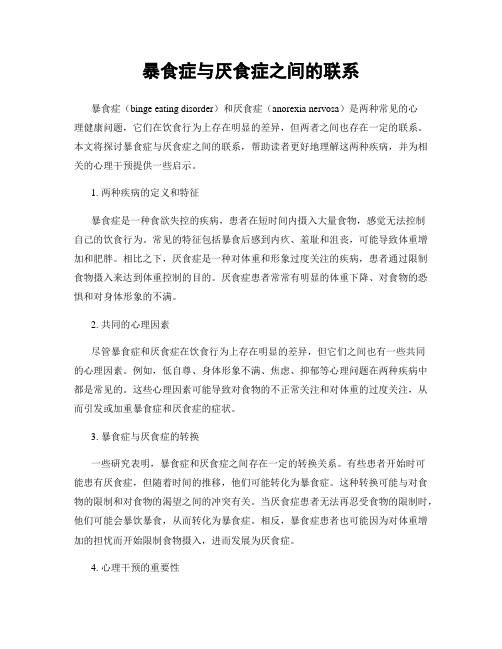
暴食症与厌食症之间的联系暴食症(binge eating disorder)和厌食症(anorexia nervosa)是两种常见的心理健康问题,它们在饮食行为上存在明显的差异,但两者之间也存在一定的联系。
本文将探讨暴食症与厌食症之间的联系,帮助读者更好地理解这两种疾病,并为相关的心理干预提供一些启示。
1. 两种疾病的定义和特征暴食症是一种食欲失控的疾病,患者在短时间内摄入大量食物,感觉无法控制自己的饮食行为。
常见的特征包括暴食后感到内疚、羞耻和沮丧,可能导致体重增加和肥胖。
相比之下,厌食症是一种对体重和形象过度关注的疾病,患者通过限制食物摄入来达到体重控制的目的。
厌食症患者常常有明显的体重下降、对食物的恐惧和对身体形象的不满。
2. 共同的心理因素尽管暴食症和厌食症在饮食行为上存在明显的差异,但它们之间也有一些共同的心理因素。
例如,低自尊、身体形象不满、焦虑、抑郁等心理问题在两种疾病中都是常见的。
这些心理因素可能导致对食物的不正常关注和对体重的过度关注,从而引发或加重暴食症和厌食症的症状。
3. 暴食症与厌食症的转换一些研究表明,暴食症和厌食症之间存在一定的转换关系。
有些患者开始时可能患有厌食症,但随着时间的推移,他们可能转化为暴食症。
这种转换可能与对食物的限制和对食物的渴望之间的冲突有关。
当厌食症患者无法再忍受食物的限制时,他们可能会暴饮暴食,从而转化为暴食症。
相反,暴食症患者也可能因为对体重增加的担忧而开始限制食物摄入,进而发展为厌食症。
4. 心理干预的重要性对于暴食症和厌食症患者来说,心理干预是非常重要的治疗手段。
心理治疗可以帮助患者了解和处理他们的负面情绪,提高自尊和身体形象满意度,改变不健康的饮食观念和行为。
认知行为疗法(cognitive-behavioral therapy)是一种常用的心理干预方法,它帮助患者识别和改变不健康的思维模式和行为习惯。
此外,家庭疗法、支持性心理治疗和营养咨询等也可以作为辅助治疗手段。
ED进食障碍症诊断标准
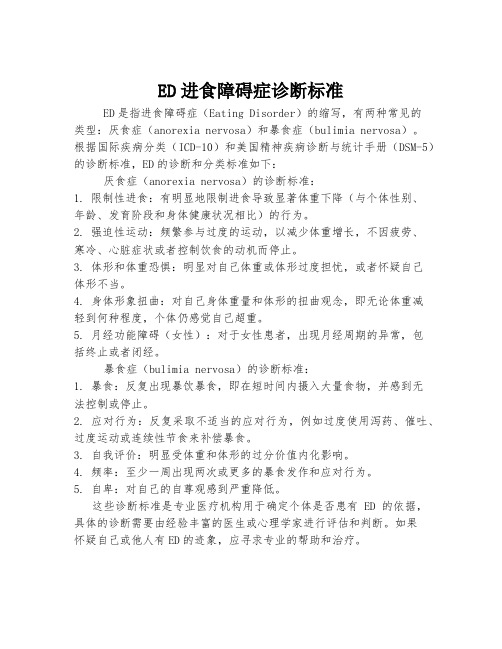
ED进食障碍症诊断标准ED是指进食障碍症(Eating Disorder)的缩写,有两种常见的类型:厌食症(anorexia nervosa)和暴食症(bulimia nervosa)。
根据国际疾病分类(ICD-10)和美国精神疾病诊断与统计手册(DSM-5)的诊断标准,ED的诊断和分类标准如下:厌食症(anorexia nervosa)的诊断标准:1. 限制性进食:有明显地限制进食导致显著体重下降(与个体性别、年龄、发育阶段和身体健康状况相比)的行为。
2. 强迫性运动:频繁参与过度的运动,以减少体重增长,不因疲劳、寒冷、心脏症状或者控制饮食的动机而停止。
3. 体形和体重恐惧:明显对自己体重或体形过度担忧,或者怀疑自己体形不当。
4. 身体形象扭曲:对自己身体重量和体形的扭曲观念,即无论体重减轻到何种程度,个体仍感觉自己超重。
5. 月经功能障碍(女性):对于女性患者,出现月经周期的异常,包括终止或者闭经。
暴食症(bulimia nervosa)的诊断标准:1. 暴食:反复出现暴饮暴食,即在短时间内摄入大量食物,并感到无法控制或停止。
2. 应对行为:反复采取不适当的应对行为,例如过度使用泻药、催吐、过度运动或连续性节食来补偿暴食。
3. 自我评价:明显受体重和体形的过分价值内化影响。
4. 频率:至少一周出现两次或更多的暴食发作和应对行为。
5. 自卑:对自己的自尊观感到严重降低。
这些诊断标准是专业医疗机构用于确定个体是否患有ED的依据,具体的诊断需要由经验丰富的医生或心理学家进行评估和判断。
如果怀疑自己或他人有ED的迹象,应寻求专业的帮助和治疗。
病例28-神经性厌食症患者的临床护理-完稿

神经性厌食症病人的护理神经性厌食症(Anorexia Nervosa, AN)是一种以病态的对肥胖的恐惧、体像障碍(body-image disorder)、过分追求苗条为特点的一种进食障碍,其表现涉及生理、行为及心理活动各个方面。
此类病人大多数为年轻女性,起病年龄通常在10~30岁之间,其中85%左右在13~20岁之间起病,高峰年龄为17~18岁。
病人一般开始时只是普通的节食,之后出现失控,其核心的心理特征是特有的关于体型和体重的超价观念。
病人可能对自己的身体有歪曲的体象,即使体重过低仍认为自己太胖。
为了追求苗条,病人可能采取节食、禁食、引吐、过度运动、滥用泻药等方式。
【病例】病人HY,女性,16岁,高一学生,持续节食,伴频繁暴食并引吐、消瘦、频繁晕厥、闭经、成绩下降、社交退缩、情绪低落,持续1年余。
一、诊疗过程中的临床护理(一)入院时1.诊疗情况据病人家属介绍,病人性格内向,敏感,自尊心强,上小学时学习成绩一直是班里前三名,一直是班里的班长。
在上小学时,病人体型较胖,曾被班里的男同学取笑,为此气恼,但从未向家人和老师提及,仅对自己的好朋友哭诉过。
到了初二时,病人的发育速度较快,体重(75Kg)和身高(170cm)明显增加,出现第二性征、初潮,班里的男同学给起了“傻大个”的外号,为此经常哭泣,学习成绩开始下降,从前五名下降至十八名。
病人上网搜索减肥方法,开始每日节食,早饭不吃,晚上仅吃一个苹果,不吃薯片、肉类(尤其是肥肉),其间偶尔出现几次暴饮暴食,进食后自行催吐,每天下课后在学校坚持跑5000米。
持续一年后,病人体型明显改善,体重降至55Kg,身高长到172cm,班中同学对其刮目相看,部分女同学也开始效仿,病人为此感到骄傲,此时病人的成绩也有所提升(升至前十名)。
进入初三后,学习压力开始增加,病人依旧节食并坚持长跑,体重降至48Kg(身高173cm)。
偶尔在上课时出现晕厥,出现闭经,记忆力下降,学习吃力,家人曾带病人在综合性医院就诊,检查结果未见明显异常,医生建议增加营养摄入,停止节食。
神经性厌食症名词解释

神经性厌食症名词解释神经性厌食症(Anorexia nervosa)是一种食欲减少的心理疾病,患者对体重和身体形态过分关注,经常通过限制饮食、过度运动或引发呕吐来控制体重。
神经性厌食症主要发生在青少年女性群体中,但也可发生在男性和其他年龄段的人群中。
主要特征:神经性厌食症患者通常对自己的体重和形态感到过度担忧,常常认为自己过胖。
以下是神经性厌食症的主要特征:1. 饮食限制:患者会刻意限制饮食,拒绝进食足够的热量以维持身体需要的能量,表现为食量明显减少或拒绝进食。
2. 引发呕吐:有些患者进食后会引起自我催吐,以减少所摄入的食物。
这种行为可能有助于患者维持相对较低的体重。
3. 过度运动:患者为了减肥会进行过度运动,以消耗更多的热量。
4. 强迫控制:患者对体重和形态有过分的控制欲望,并出现严重的自我否定和自卑情绪。
5. 身体变化:患者的体重在短期内急剧下降,虽然体重可能已经达到危险水平,但患者仍会坚持控制体重。
6. 带有执念的追求完美:患者对自己的外貌要求极高,并表现出对身体形态的异常担忧。
7. 对食物的恐惧:患者会因为害怕增加体重而回避各种食物,尤其是高热量食物。
患者常常不认识到自己的病态行为,坚持认为自己过于胖,即使已经明显消瘦。
治疗:神经性厌食症是一种严重的心理健康问题,需要综合性的治疗方法。
以下是常见的治疗方法:1. 药物治疗:抗抑郁药和抗焦虑药可以帮助改善患者的心理健康状况。
2. 心理治疗:认知行为疗法和家庭治疗等心理治疗方法可以帮助患者重新建立健康的饮食习惯和改善身体形态的认知。
3. 营养辅导:由专业的营养师提供营养咨询和指导,帮助患者建立健康的饮食计划。
4. 医学监测:定期体检和监测患者的生理指标,以确保他们的身体状况得到控制和改善。
尽早识别和治疗神经性厌食症非常重要,因为它可能会对患者的健康产生严重影响,并导致生命威胁的并发症。
神经性厌食症的症状及心理治疗

神经性厌食症的症状及心理治疗一、介绍神经性厌食症(Anorexia Nervosa)是一种严重影响身体健康的精神障碍,主要表现为极度追求苗条身材,拒绝进食导致明显体重减轻。
该疾病主要发生在青少年女性中,但近年来男性患者也呈增加趋势。
本文将详细探讨神经性厌食症的典型症状以及心理治疗的有效方法。
二、典型症状1. 拒绝进食与营养不良神经性厌食症患者常常拒绝或限制自己的进食量,尤其是高能量和高脂肪的食物。
此外,他们对摄入卡路里非常敏感,并往往过度计算能量消耗。
长时间持续的饮食限制导致营养摄取不足,从而引起身体多个系统的异常功能。
2. 明显体重下降由于饮食限制和过度运动等原因,神经性厌食症患者常出现体重迅速减轻的情况。
他们对自己身材的不满意和过度追求苗条可能成为主要动力,导致极端的减重行为,进而触发更多身体与心理问题。
3. 强迫性运动神经性厌食症患者通常表现出强迫性、过度频繁的运动习惯。
他们会选择高强度、高耗能量的运动方式,以达到额外消耗卡路里的目的。
这些行为有可能加重身体虚弱和损害健康。
4. 对体型和体重监控过度患有神经性厌食症的人会对自己的体型和体重进行过度关注,并以之为评价自我价值和控制感受的依据。
他们通常会使用各种工具如称重器、镜子等来监控变化,并将其作为衡量自我的标准。
三、心理治疗方法1. 调整恶劣思维神经性厌食症患者内心往往充斥着负面、扭曲而恶劣的思维模式。
心理治疗可以帮助他们理解和改变这些思维,培养积极、健康的自我认知。
常用的方法包括认知行为疗法(CBT)和追踪歪曲思想模式。
2. 自尊教育与建立身份神经性厌食症患者常常对自己产生负面评价,并丧失了个体的自尊感。
心理治疗可以通过帮助患者探索自身需求、发展个人爱好、建立工作身份等方式,逐渐重塑患者对自我的认同和接纳。
3. 家庭治疗神经性厌食症的发展与家庭环境密切相关。
因此,与患者共同居住的家庭成员应参与到治疗过程中,并接受特定技巧指导。
通过加强亲密关系、改善沟通能力以及学习处理冲突和压力的策略,可以促进整个家庭恢复健康。
神经性厌食症的诊断与心理治疗
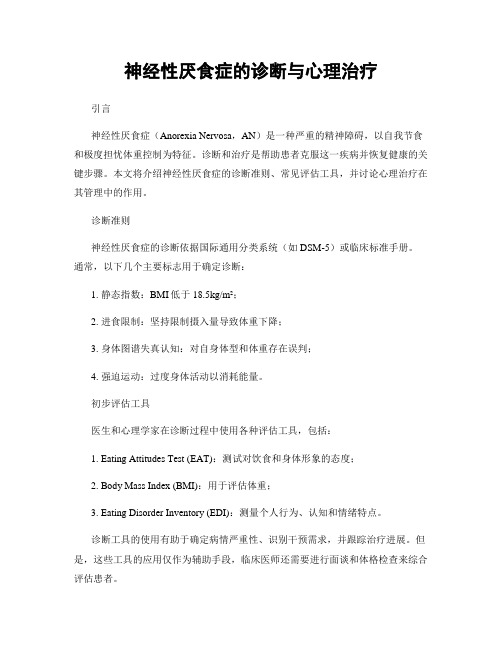
神经性厌食症的诊断与心理治疗引言神经性厌食症(Anorexia Nervosa,AN)是一种严重的精神障碍,以自我节食和极度担忧体重控制为特征。
诊断和治疗是帮助患者克服这一疾病并恢复健康的关键步骤。
本文将介绍神经性厌食症的诊断准则、常见评估工具,并讨论心理治疗在其管理中的作用。
诊断准则神经性厌食症的诊断依据国际通用分类系统(如DSM-5)或临床标准手册。
通常,以下几个主要标志用于确定诊断:1. 静态指数:BMI低于18.5kg/m²;2. 进食限制:坚持限制摄入量导致体重下降;3. 身体图谱失真认知:对自身体型和体重存在误判;4. 强迫运动:过度身体活动以消耗能量。
初步评估工具医生和心理学家在诊断过程中使用各种评估工具,包括:1. Eating Attitudes Test (EAT):测试对饮食和身体形象的态度;2. Body Mass Index (BMI):用于评估体重;3. Eating Disorder Inventory (EDI):测量个人行为、认知和情绪特点。
诊断工具的使用有助于确定病情严重性、识别干预需求,并跟踪治疗进展。
但是,这些工具的应用仅作为辅助手段,临床医师还需要进行面谈和体格检查来综合评估患者。
心理治疗方法心理治疗在神经性厌食症管理中起着至关重要的作用。
以下是常见的心理治疗方法:认知行为疗法(Cognitive-Behavioral Therapy, CBT)CBT是一种有力的心理治疗方法,致力于帮助患者改变不健康的思维模式和行为习惯。
它通过以下几种方式来有效地处理神经性厌食症:1. 意识到错误信念:帮助患者认识到自身对体形、体重等方面存在错误认知;2. 行为干预:建立规律进食时间、降低过度运动程度等;3. 日记记录:让患者记录饮食、情绪和行为,以便识别潜在问题和触发因素。
家庭治疗由于神经性厌食症与家庭环境密切相关,波恩治疗模型(Maudsley Model)具有显著的效果。
神经性厌食症的诊断标准
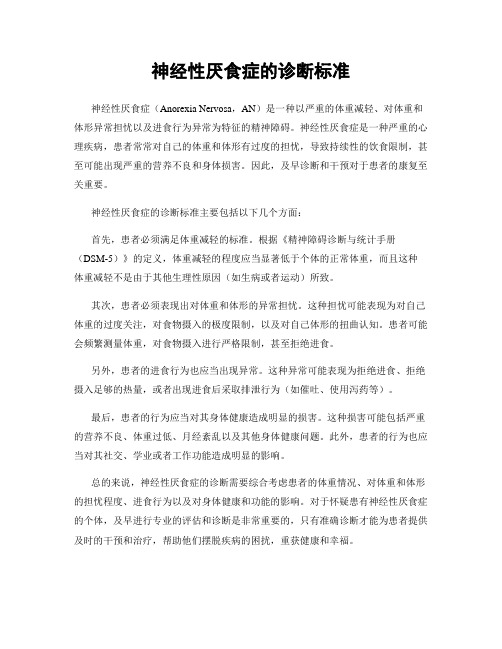
神经性厌食症的诊断标准神经性厌食症(Anorexia Nervosa,AN)是一种以严重的体重减轻、对体重和体形异常担忧以及进食行为异常为特征的精神障碍。
神经性厌食症是一种严重的心理疾病,患者常常对自己的体重和体形有过度的担忧,导致持续性的饮食限制,甚至可能出现严重的营养不良和身体损害。
因此,及早诊断和干预对于患者的康复至关重要。
神经性厌食症的诊断标准主要包括以下几个方面:首先,患者必须满足体重减轻的标准。
根据《精神障碍诊断与统计手册(DSM-5)》的定义,体重减轻的程度应当显著低于个体的正常体重,而且这种体重减轻不是由于其他生理性原因(如生病或者运动)所致。
其次,患者必须表现出对体重和体形的异常担忧。
这种担忧可能表现为对自己体重的过度关注,对食物摄入的极度限制,以及对自己体形的扭曲认知。
患者可能会频繁测量体重,对食物摄入进行严格限制,甚至拒绝进食。
另外,患者的进食行为也应当出现异常。
这种异常可能表现为拒绝进食、拒绝摄入足够的热量,或者出现进食后采取排泄行为(如催吐、使用泻药等)。
最后,患者的行为应当对其身体健康造成明显的损害。
这种损害可能包括严重的营养不良、体重过低、月经紊乱以及其他身体健康问题。
此外,患者的行为也应当对其社交、学业或者工作功能造成明显的影响。
总的来说,神经性厌食症的诊断需要综合考虑患者的体重情况、对体重和体形的担忧程度、进食行为以及对身体健康和功能的影响。
对于怀疑患有神经性厌食症的个体,及早进行专业的评估和诊断是非常重要的,只有准确诊断才能为患者提供及时的干预和治疗,帮助他们摆脱疾病的困扰,重获健康和幸福。
在诊断过程中,医生应当充分了解患者的病史、症状和体征,进行全面的体格检查和心理评估,排除其他可能的身体疾病和精神障碍,从而确保诊断的准确性。
同时,患者的家人和社会支持系统也应当积极参与,为患者提供支持和关爱,协助他们走出疾病的阴影。
总之,神经性厌食症的诊断标准涉及体重减轻、对体重和体形的异常担忧、进食行为异常以及对身体健康和功能的影响。
神经性厌食症进展
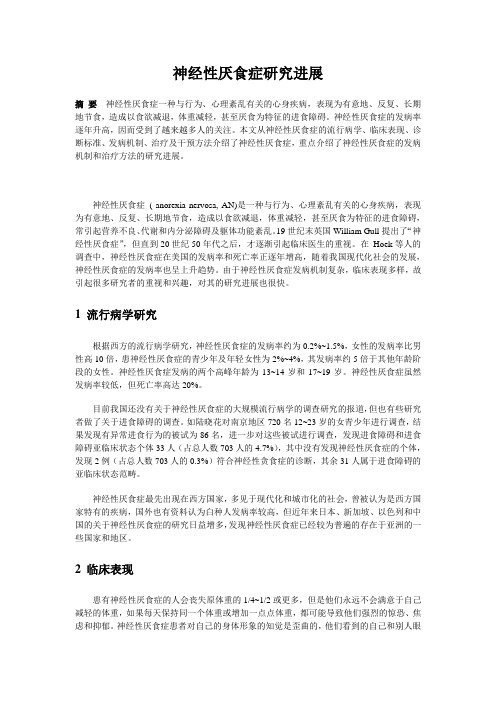
神经性厌食症研究进展摘要神经性厌食症一种与行为、心理紊乱有关的心身疾病,表现为有意地、反复、长期地节食,造成以食欲减退,体重减轻,甚至厌食为特征的进食障碍。
神经性厌食症的发病率逐年升高,因而受到了越来越多人的关注。
本文从神经性厌食症的流行病学、临床表现、诊断标准、发病机制、治疗及干预方法介绍了神经性厌食症,重点介绍了神经性厌食症的发病机制和治疗方法的研究进展。
神经性厌食症( anorexia nervosa, AN)是一种与行为、心理紊乱有关的心身疾病,表现为有意地、反复、长期地节食,造成以食欲减退,体重减轻,甚至厌食为特征的进食障碍,常引起营养不良、代谢和内分泌障碍及躯体功能紊乱。
19世纪末英国William Gull提出了“神经性厌食症”,但直到20世纪50年代之后,才逐渐引起临床医生的重视。
在Hoek等人的调查中,神经性厌食症在美国的发病率和死亡率正逐年增高,随着我国现代化社会的发展,神经性厌食症的发病率也呈上升趋势。
由于神经性厌食症发病机制复杂,临床表现多样,故引起很多研究者的重视和兴趣,对其的研究进展也很快。
1 流行病学研究根据西方的流行病学研究,神经性厌食症的发病率约为0.2%~1.5%,女性的发病率比男性高10倍,患神经性厌食症的青少年及年轻女性为2%~4%,其发病率约5倍于其他年龄阶段的女性。
神经性厌食症发病的两个高峰年龄为13~14岁和17~19岁。
神经性厌食症虽然发病率较低,但死亡率高达20%。
目前我国还没有关于神经性厌食症的大规模流行病学的调查研究的报道,但也有些研究者做了关于进食障碍的调查。
如陆晓花对南京地区720名12~23岁的女青少年进行调查,结果发现有异常进食行为的被试为86名,进一步对这些被试进行调查,发现进食障碍和进食障碍亚临床状态个体33人(占总人数703人的4.7%),其中没有发现神经性厌食症的个体,发现2例(占总人数703人的0.3%)符合神经性贪食症的诊断,其余31人属于进食障碍的亚临床状态范畴。
神经性厌食症治疗神经性厌食症的方法和心理支持建议
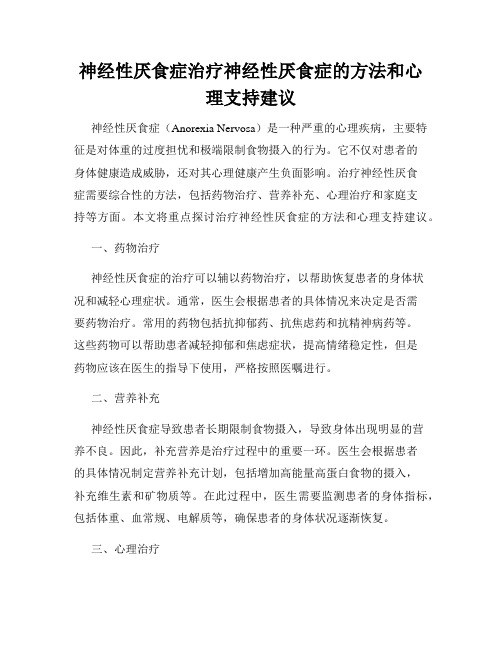
神经性厌食症治疗神经性厌食症的方法和心理支持建议神经性厌食症(Anorexia Nervosa)是一种严重的心理疾病,主要特征是对体重的过度担忧和极端限制食物摄入的行为。
它不仅对患者的身体健康造成威胁,还对其心理健康产生负面影响。
治疗神经性厌食症需要综合性的方法,包括药物治疗、营养补充、心理治疗和家庭支持等方面。
本文将重点探讨治疗神经性厌食症的方法和心理支持建议。
一、药物治疗神经性厌食症的治疗可以辅以药物治疗,以帮助恢复患者的身体状况和减轻心理症状。
通常,医生会根据患者的具体情况来决定是否需要药物治疗。
常用的药物包括抗抑郁药、抗焦虑药和抗精神病药等。
这些药物可以帮助患者减轻抑郁和焦虑症状,提高情绪稳定性,但是药物应该在医生的指导下使用,严格按照医嘱进行。
二、营养补充神经性厌食症导致患者长期限制食物摄入,导致身体出现明显的营养不良。
因此,补充营养是治疗过程中的重要一环。
医生会根据患者的具体情况制定营养补充计划,包括增加高能量高蛋白食物的摄入,补充维生素和矿物质等。
在此过程中,医生需要监测患者的身体指标,包括体重、血常规、电解质等,确保患者的身体状况逐渐恢复。
三、心理治疗心理治疗是治疗神经性厌食症的核心内容。
常见的心理治疗方法包括认知行为疗法(Cognitive Behavioral Therapy,CBT)、家庭治疗和心理教育等。
CBT是被广泛接受的治疗方法之一,它可以帮助患者建立更健康的饮食和运动观念,调节对体型和体重的过度关注,并改善自我评价。
家庭治疗可以帮助改善家庭之间的沟通和支持,提供情绪上的支持和理解。
心理教育是向患者和家人提供有关神经性厌食症的知识,增强他们对治疗的合作和理解。
四、心理支持建议除了专业的心理治疗外,患者还需要得到周围人的支持和关爱。
以下是一些建议,帮助患者在治疗过程中得到更好的心理支持:1.倾诉和倾听:患者可以找一个信任的人倾诉自己的感受和困惑,与其交流有助于缓解压力和情绪。
神经性厌食症的病因是什么?
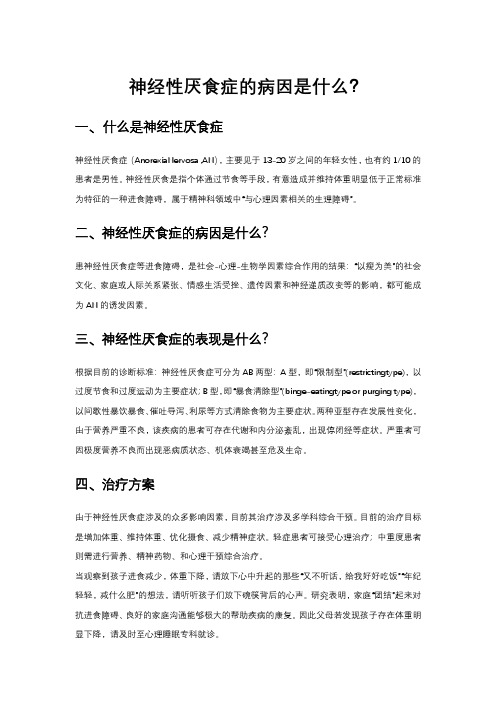
神经性厌食症的病因是什么?一、什么是神经性厌食症神经性厌食症(AnorexiaNervosa ,AN),主要见于13-20岁之间的年轻女性,也有约1/10的患者是男性。
神经性厌食是指个体通过节食等手段,有意造成并维持体重明显低于正常标准为特征的一种进食障碍,属于精神科领域中“与心理因素相关的生理障碍”。
二、神经性厌食症的病因是什么?患神经性厌食症等进食障碍,是社会-心理-生物学因素综合作用的结果:“以瘦为美”的社会文化、家庭或人际关系紧张、情感生活受挫、遗传因素和神经递质改变等的影响,都可能成为AN的诱发因素。
三、神经性厌食症的表现是什么?根据目前的诊断标准:神经性厌食症可分为AB两型:A型,即“限制型”(restrictingtype),以过度节食和过度运动为主要症状;B型,即“暴食清除型”(binge-eatingtype or purging type),以间歇性暴饮暴食、催吐导泻、利尿等方式清除食物为主要症状。
两种亚型存在发展性变化,由于营养严重不良,该疾病的患者可存在代谢和内分泌紊乱,出现停闭经等症状。
严重者可因极度营养不良而出现恶病质状态、机体衰竭甚至危及生命。
四、治疗方案由于神经性厌食症涉及的众多影响因素,目前其治疗涉及多学科综合干预。
目前的治疗目标是增加体重、维持体重、优化摄食、减少精神症状。
轻症患者可接受心理治疗;中重度患者则需进行营养、精神药物、和心理干预综合治疗。
当观察到孩子进食减少,体重下降,请放下心中升起的那些“又不听话,给我好好吃饭”“年纪轻轻,减什么肥”的想法,请听听孩子们放下碗筷背后的心声。
研究表明,家庭“团结”起来对抗进食障碍、良好的家庭沟通能够极大的帮助疾病的康复。
因此父母若发现孩子存在体重明显下降,请及时至心理睡眠专科就诊。
心理治疗对神经性厌食症的疗效评估

心理治疗对神经性厌食症的疗效评估概述:神经性厌食症(Nervosa Anorexia)是一种以极度担忧体重、食物限制和严重消瘦为特征的精神障碍。
心理治疗在神经性厌食症的治疗中起着至关重要的作用。
本文将探讨心理治疗对神经性厌食症患者的疗效评估。
一、认知行为治疗对神经性厌食症的影响认知行为治疗(CBT)是一种广泛被应用于治疗各类心理障碍的心理治疗方法。
对于神经性厌食症患者来说,CBT强调改变不健康的思维模式和行为习惯。
1. 改变负向思维模式CBT通过帮助患者识别和挑战负向思维模式,如完美主义和自我批判,引导他们形成更积极、更现实的思维方式。
患者逐渐意识到自己不必追求完美,并学会接受自己的身体形象。
2. 感知和处理身体形象CBT还通过帮助患者调整对自己身体的感知,使他们能够更加客观地评估自己的状况。
此外,患者学习逐渐接纳自己的身体,并在取得进展时对自己进行积极强化。
3. 提高日常功能神经性厌食症患者常常存在着控制追求、刻板行为和社交障碍等问题。
CBT帮助患者学会处理这些问题,提高他们的日常功能。
例如,通过反馈机制和解决问题的技巧,帮助患者改善人际关系并减少控制需求。
二、家庭治疗对神经性厌食症的影响家庭治疗是一种以整个家庭系统为焦点的心理治疗方法。
对于神经性厌食症患者来说,改善家庭环境和提升支持系统至关重要。
1. 改善沟通模式家庭治疗旨在修复和改善家庭成员之间的沟通模式。
通过增加亲密度、尊重和理解,患者和家人之间的联系得以加强。
良好的沟通可以减少患者对厌食行为的需求。
2. 提供支持和教育家庭治疗还为家庭成员提供必要的支持和教育。
这有助于增加对神经性厌食症的了解,并帮助他们更好地支持患者的康复过程。
同时,家庭成员也可分享彼此之间的经验与情感,从而建立更强大的支持系统。
3. 降低紧张和冲突神经性厌食症常常伴随着家庭争吵、紧张和冲突。
通过开展家庭治疗,可以促进沟通和谐,并寻找解决问题的方法。
消除紧张与冲突有助于缓解患者内心的压力,提升他们接受治疗并恢复健康的可能性。
劳拉西泮对神经性厌食症的治疗效果评估
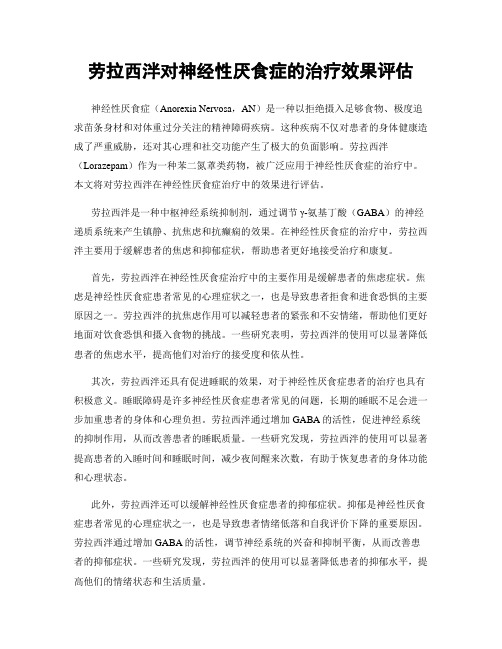
劳拉西泮对神经性厌食症的治疗效果评估神经性厌食症(Anorexia Nervosa,AN)是一种以拒绝摄入足够食物、极度追求苗条身材和对体重过分关注的精神障碍疾病。
这种疾病不仅对患者的身体健康造成了严重威胁,还对其心理和社交功能产生了极大的负面影响。
劳拉西泮(Lorazepam)作为一种苯二氮䓬类药物,被广泛应用于神经性厌食症的治疗中。
本文将对劳拉西泮在神经性厌食症治疗中的效果进行评估。
劳拉西泮是一种中枢神经系统抑制剂,通过调节γ-氨基丁酸(GABA)的神经递质系统来产生镇静、抗焦虑和抗癫痫的效果。
在神经性厌食症的治疗中,劳拉西泮主要用于缓解患者的焦虑和抑郁症状,帮助患者更好地接受治疗和康复。
首先,劳拉西泮在神经性厌食症治疗中的主要作用是缓解患者的焦虑症状。
焦虑是神经性厌食症患者常见的心理症状之一,也是导致患者拒食和进食恐惧的主要原因之一。
劳拉西泮的抗焦虑作用可以减轻患者的紧张和不安情绪,帮助他们更好地面对饮食恐惧和摄入食物的挑战。
一些研究表明,劳拉西泮的使用可以显著降低患者的焦虑水平,提高他们对治疗的接受度和依从性。
其次,劳拉西泮还具有促进睡眠的效果,对于神经性厌食症患者的治疗也具有积极意义。
睡眠障碍是许多神经性厌食症患者常见的问题,长期的睡眠不足会进一步加重患者的身体和心理负担。
劳拉西泮通过增加GABA的活性,促进神经系统的抑制作用,从而改善患者的睡眠质量。
一些研究发现,劳拉西泮的使用可以显著提高患者的入睡时间和睡眠时间,减少夜间醒来次数,有助于恢复患者的身体功能和心理状态。
此外,劳拉西泮还可以缓解神经性厌食症患者的抑郁症状。
抑郁是神经性厌食症患者常见的心理症状之一,也是导致患者情绪低落和自我评价下降的重要原因。
劳拉西泮通过增加GABA的活性,调节神经系统的兴奋和抑制平衡,从而改善患者的抑郁症状。
一些研究发现,劳拉西泮的使用可以显著降低患者的抑郁水平,提高他们的情绪状态和生活质量。
然而,劳拉西泮也存在一些副作用和安全性问题需要关注。
anorexia的用法总结大全

anorexia的用法总结大全(学习版)编制人:__________________审核人:__________________审批人:__________________编制学校:__________________编制时间:____年____月____日序言下载提示:该文档是本店铺精心编制而成的,希望大家下载后,能够帮助大家解决实际问题。
文档下载后可定制修改,请根据实际需要进行调整和使用,谢谢!并且,本店铺为大家提供各种类型的经典范文,如英语单词、英语语法、英语听力、英语知识点、语文知识点、文言文、数学公式、数学知识点、作文大全、其他资料等等,想了解不同范文格式和写法,敬请关注!Download tips: This document is carefully compiled by this editor.I hope that after you download it, it can help you solve practical problems. The document can be customized and modified after downloading, please adjust and use it according to actual needs, thank you!In addition, this shop provides various types of classic sample essays, such as English words, English grammar, English listening, English knowledge points, Chinese knowledge points, classical Chinese, mathematical formulas, mathematics knowledge points, composition books, other materials, etc. Learn about the different formats and writing styles of sample essays, so stay tuned!anorexia的用法总结大全anorexia的意思anorexia的简明意思n. 厌食症英式发音 [ˌænə'reksiə] 美式发音 [ˌænə'reksiə]anorexia的具体用法如:Anorexia is one of the psychosomatic disorders.神经性厌食症是一种心身障碍.在此句中anorexia表示厌食的意思She was battling anorexia and had medical issues.她正患有厌食症,内科也有问题.在此句中anorexia表示厌食症的意思anorexia的用法例句And besides, anorexia is a psychological problem as well.而且此外, 厌食症也是一个心理问题.在此句中anorexia表示厌食症的意思The work could also explain why people with anorexia nervosa are able to deny themselves food.这一研究还解释了为什么神经性厌食症患者会拒绝进食.在此句中anorexia表示厌食症的意思Anorexia nervosa is characterized by starvation attitudes toward food, and distorted body image.神经性厌食症的特征是拒绝进食以至体形异常.在此句中anorexia表示厌食症的意思And besides, anorexia is a psychological problem as well.而且此外, 厌食症也是一个心理问题.在此句中anorexia表示厌食的意思The groups did not differ in the incidence of loss, neutropenia, thrombocytopenia, hyperlipidemia, nausea, or anorexia.脱发、中性粒细胞减少症、血小板减少症、高脂血症、恶心或厌食发生率组间无显著差异.在此句中anorexia表示厌食的意思。
神经性厌食症诊断标准
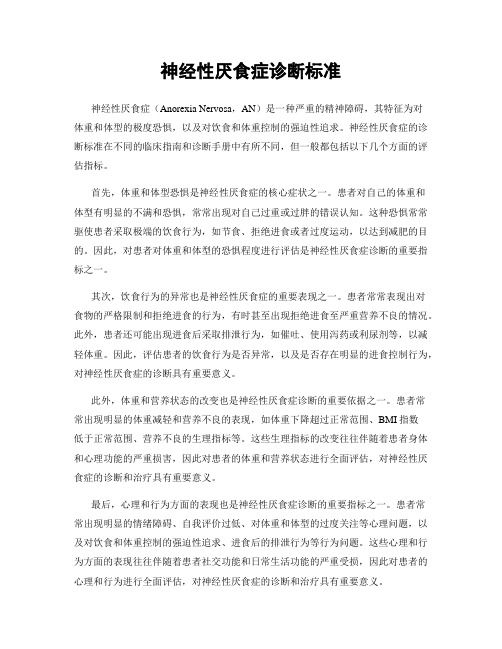
神经性厌食症诊断标准神经性厌食症(Anorexia Nervosa,AN)是一种严重的精神障碍,其特征为对体重和体型的极度恐惧,以及对饮食和体重控制的强迫性追求。
神经性厌食症的诊断标准在不同的临床指南和诊断手册中有所不同,但一般都包括以下几个方面的评估指标。
首先,体重和体型恐惧是神经性厌食症的核心症状之一。
患者对自己的体重和体型有明显的不满和恐惧,常常出现对自己过重或过胖的错误认知。
这种恐惧常常驱使患者采取极端的饮食行为,如节食、拒绝进食或者过度运动,以达到减肥的目的。
因此,对患者对体重和体型的恐惧程度进行评估是神经性厌食症诊断的重要指标之一。
其次,饮食行为的异常也是神经性厌食症的重要表现之一。
患者常常表现出对食物的严格限制和拒绝进食的行为,有时甚至出现拒绝进食至严重营养不良的情况。
此外,患者还可能出现进食后采取排泄行为,如催吐、使用泻药或利尿剂等,以减轻体重。
因此,评估患者的饮食行为是否异常,以及是否存在明显的进食控制行为,对神经性厌食症的诊断具有重要意义。
此外,体重和营养状态的改变也是神经性厌食症诊断的重要依据之一。
患者常常出现明显的体重减轻和营养不良的表现,如体重下降超过正常范围、BMI指数低于正常范围、营养不良的生理指标等。
这些生理指标的改变往往伴随着患者身体和心理功能的严重损害,因此对患者的体重和营养状态进行全面评估,对神经性厌食症的诊断和治疗具有重要意义。
最后,心理和行为方面的表现也是神经性厌食症诊断的重要指标之一。
患者常常出现明显的情绪障碍、自我评价过低、对体重和体型的过度关注等心理问题,以及对饮食和体重控制的强迫性追求、进食后的排泄行为等行为问题。
这些心理和行为方面的表现往往伴随着患者社交功能和日常生活功能的严重受损,因此对患者的心理和行为进行全面评估,对神经性厌食症的诊断和治疗具有重要意义。
综上所述,神经性厌食症的诊断标准主要包括对体重和体型恐惧、饮食行为的异常、体重和营养状态的改变,以及心理和行为方面的表现进行全面评估。
神经性厌食症 ppt课件

鉴别诊断
► 1.躯体疾病:很多躯体疾病如大脑的肿瘤或癌症,可导致明
显的体重减轻,应通过相关检查予以排除引起体重减轻的躯 体疾病。AN患者普遍存在内分泌紊乱,应通过相关检查排除 原发内分泌疾病。
► 2.抑郁症:抑郁症患者往往有食欲减退的特点,而AN患者食
欲正常并有饥饿感,只在严重阶段AN患者才有食欲减退;抑 郁症病人没有AN患者强烈的肥胖恐惧或体像障碍;AN中常见 活动过度,是计划好的仪式性行为,对食谱和食物卡路里含 量的先占观念,而抑郁症病人中并没有。
系统的家庭治疗有助于缓解症状,减少复发。
ppt课件
12
神经性厌食症适宜食物—开胃健脾
u 营养原则 宜吃具有补脾气、性平、性温、味甘、营养丰富、
容易消化的食品。忌吃性寒凉,易损伤脾气,味厚滋腻,容 易阻碍脾气运化功能的食品。
u 适宜食物 1、谷物及豆类:粳米、籼米、玉米、薏米、番薯、
豆腐等。 2、肉、蛋、奶类:牛肉、兔肉、牛肚、猪肚、桂 鱼、乌鸡等。 3、蔬菜类:藕、粟子、山药、扁豆、豇豆、 胡萝卜、马铃薯、洋葱、平菇等。 4、水果类:葡萄、红枣、 桃、杏等。
u u
[健脾开胃] 拔丝地瓜 [健脾开胃] 川味啤酒鸭 ppt课件
13
神经性厌食症适宜食物
► 孜然 对消化不良、胃寒疼痛、肾虚便频均有疗效。中医认
为,孜然气味甘甜,辛温无毒,具有温中暖脾、开胃下气、 消食化积、醒脑通脉、祛寒除湿等功效。
► 米酒 即醪糟中的汤汁,饮后能开胃提神。 对神经衰弱、精
神恍惚、抑郁健忘等症有较好功效,加鸡蛋同煮饮汤效果较 佳。
4、常可有下丘脑-垂体-性腺轴的 广泛内分泌紊乱: 闭经、性兴趣丧失、外周甲状 腺素代谢异常、胰岛素分泌异 常。
食欲不振的护理1234
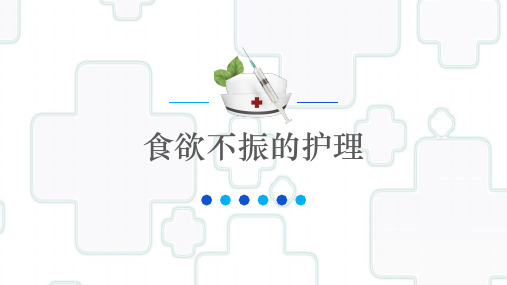
6.内分泌激素测定 包括甲状腺激素及肾上腺皮质激素测定,有助于
明确是否有甲状腺功能低下和肾上腺皮质功能低下。
7.心理测评 对疑有神经精神因素致食欲不振者,可予心理测评。
常见护理诊断/问题
1.营养失调:低于机体需要量 与摄人不足有关。 2.潜在并发症:水、电解质紊乱。
护理措施
1.一般护理
评估患者食欲不振的原因,做到有针对性的护理,对于由疾病 相关因素造成的食欲不振,配合医嘱治疗,以便改善症状。
创造良好的进餐环境,尽量把便盆痰盂和换药时脓痰血迹消 除干净,避免恶性刺激病室做到无异味。
护理措施
2.饮食护理
根据患者所患疾病, 遵医嘱选择不同的饮食,同时耍寻求患 者意愿,不仅要注意营养全面,还要尽量做到色香、味形俱全,以 增加患者的食欲。
食欲不振的护理
食欲不振(anorexia)是指对食物 缺乏需求的欲望,严重的食欲不振称 为厌食。
目录CONTENT
01
常见病因
02
辅助检查
03
常见护理 诊断/问题
04
护理措施
消化系统疾病 急、慢性胃炎、功能性消化不良、消化性 溃疡、消化0系00111统肿瘤、胃大部切除术后、 急慢性肝炎、药物性肝炎、酒精性肝病、 肝硬化、肠道疾病、全身性疾病、 慢性心、0002肺22 、肾功00能33 不全、严重贫血 消化系统外恶性肿瘤
血液系统恶性肿瘤
急性感染 结核病
辅助检查
辅助检查
3.腹水检查 对伴有腹水的患者行腹水常规、生化、肿瘤脱落细胞、细
菌培养等检查,可帮助明确腹水的性质,进一步判断原发病。
4.胸腹部CT、腹部超声 进一步确定有无肺部炎症、结核、肿瘤性病
什么是厌食症?
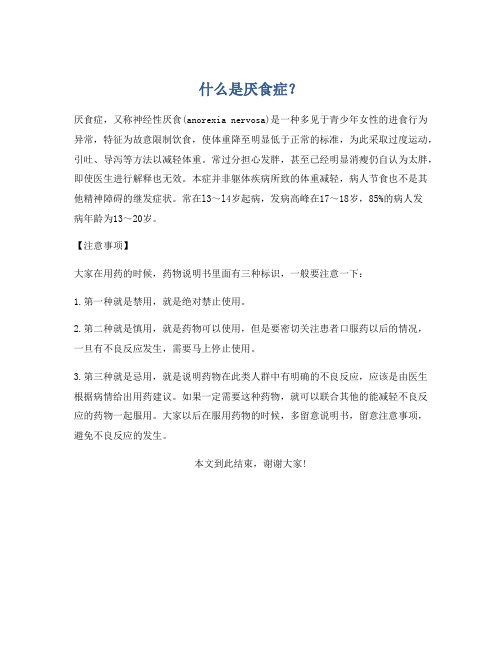
什么是厌食症?
厌食症,又称神经性厌食(anorexia nervosa)是一种多见于青少年女性的进食行为异常,特征为故意限制饮食,使体重降至明显低于正常的标准,为此采取过度运动,引吐、导泻等方法以减轻体重。
常过分担心发胖,甚至已经明显消瘦仍自认为太胖,即使医生进行解释也无效。
本症并非躯体疾病所致的体重减轻,病人节食也不是其他精神障碍的继发症状。
常在l3~l4岁起病,发病高峰在17~18岁,85%的病人发
病年龄为13~20岁。
【注意事项】
大家在用药的时候,药物说明书里面有三种标识,一般要注意一下:
1.第一种就是禁用,就是绝对禁止使用。
2.第二种就是慎用,就是药物可以使用,但是要密切关注患者口服药以后的情况,一旦有不良反应发生,需要马上停止使用。
3.第三种就是忌用,就是说明药物在此类人群中有明确的不良反应,应该是由医生根据病情给出用药建议。
如果一定需要这种药物,就可以联合其他的能减轻不良反应的药物一起服用。
大家以后在服用药物的时候,多留意说明书,留意注意事项,避免不良反应的发生。
本文到此结束,谢谢大家!。
- 1、下载文档前请自行甄别文档内容的完整性,平台不提供额外的编辑、内容补充、找答案等附加服务。
- 2、"仅部分预览"的文档,不可在线预览部分如存在完整性等问题,可反馈申请退款(可完整预览的文档不适用该条件!)。
- 3、如文档侵犯您的权益,请联系客服反馈,我们会尽快为您处理(人工客服工作时间:9:00-18:30)。
It's only human to wish you looked different or could fix something about yourself. But when a preoccupation with being thin takes over your eating habits, thoughts, and life, it's a sign of an eating disorder. When you have anorexia, the desire to lose weight becomes more important than anything else. You may even lose the ability to see yourself as you truly are.Anorexia is a serious eating disorder that affects women and men of all ages. It can damage your health and even threaten your life. But you're not alone. There's help available when you're ready to make a change. You deserve to be happy. Treatment will help you feel better and learn to value yourself.What is anorexia nervosa?Anorexia nervosa is a complex eating disorder with three key features: •refusal to maintain a healthy body weight•an intense fear of gaining weight• a distorted body imageBecause of your dread of becoming fat or disgusted with how your body looks, eating and mealtimes may be very stressful. And yet, what you can and can’t eat is practically all you can think about.Thoughts about dieting, food, and your body may take up most of your day—leaving little time for friends, family, and other activities you used to enjoy. Life becomes a relentless pursuit of thinness and going to extremes to lose weight.But no matter how skinny you become, it’s never enough.While people with anorexia often deny having a problem, the truth is that anorexia is a serious and potentially deadly eating disorder. Fortunately, recovery is possible. With proper treatment and support, you or someone you care about can break anorexia’s self-destructive pattern and regain health and self-confidence.Maria’s StorySeventeen-year-old Maria has been on one diet or another since she was in junior high. She recently lost 10 pounds from an already slender frame after becoming a strict vegetarian. Her parents are concerned about the weight loss, bu t Maria insists that she’s just under stress at school.Meanwhile, her vegetarian diet is becoming stricter by the day.Maria obsessively counts calories, measures food portions, and weighs herself at least twicea day. She refuses to eat at restaurants, in the school cafeteria, or anywhere else in public, and she lives on salad dressed with vinegar, rice cakes, and sugar-free Jello. Maria also hasa large stash of fat-free candy in her room. She allows herself to indulge as long as she goes for a run right afterwards.Types of anorexia nervosaThere are two types of anorexia. In the restricting type of anorexia, weight loss is achieved by restricting calories (following drastic diets, fasting, and exercising to excess). In the purging type of anorexia, weight loss is achieved by vomiting or using laxatives and diuretics.•Do you feel fat even though people te ll you you’re not?•Are you terrified of gaining weight?•Do you lie about how much you eat or hide your eating habits from others?•Are your friends or family concerned about your weight loss, eating habits, or appearance?•Do you diet, compulsively exercise, or purge when you’re feeling overwhelmed or bad about yourself?•Do you feel powerful or in control when you go without food, over-exercise, or purge?•Do you base your self-worth on your weight or body size?Anorexia is not about weight or foodBelieve it or not, anorexia isn’t really about food and weight—at least not at its core. Eating disorders are much more complicated than that. The food and weight-related issues are symptoms of something deeper: things like depression, loneliness, insecurity, pressure to be perfect, or feeling out of control. Things that no amount of dieting or weight loss can cure.What need does anorexia meet in your life?It’s important to understand that anorexia meets a need in your life. For example, you may feel powerless in many parts of your life, but you can control what you eat. Saying “no” to food, getting the best of hunger, and controlling the number on the scale may make you feel strong and successful—at least for a short while. You may even come to enjoy your hunger pa ngs as reminders of a “special talent” that most people can’t achieve.Anorexia may also be a way of distracting yourself from difficult emotions. When you spend most of your time thinking about food, dieting, and weight loss, you don’t have to face other problems in your life or deal with complicated emotions.Unfortunately, any boost you get from starving yourself or shedding pounds is extremely short-lived. Dieting and weight loss can’t repair the negative self-image at the heart of anorexia. The only way to do that is to identify the emotional need that self-starvation fulfills and find other ways to meet it.Signs and symptoms of anorexiaLiving with anorexia means you’re constantly hiding your habits. This makes it hard at first for friends and family to spot the warning signs. When confronted, you might try to explain away your disordered eating and wave away concerns. But as anorexia progresses, people close to you wont be able to deny their instincts that something is wrong—and neither should you.As anorexia develops, you become increasingly preoccupied with the number on the scale, how you look in the mirror, and what you can and can’t eat.Anorexic food behavior signs and symptoms•Dieting despite being thin– Following a severely restricted diet.Eating only certain low-calorie foods. Banning “bad” foods such as carbohydrates and fats.•Obsession with calories, fat grams, and nutrition– Reading food labels, measuring and weighing portions, keeping a food diary, reading diet books.•Pretending to eat or lying about eating–Hiding, playing with, or throwing away food to avoid eating. Making excuses to get out of meals (“I had a huge lunch” or “My stomach isn’t feeling good”).•Preoccupation with food–Constantly thinking about food. Cooking for others, collecting recipes, reading food magazines, or making meal plans while eating very little.•Strange or secretive food rituals– Refusing to eat around others or in public places. Eating in rigid, ritualistic ways (e.g. cutting food “just so," chewing food and spitting it out, using a specific plate).Anorexic appearance and body image signs and symptoms•Dramatic weight loss –Rapid, drastic weight loss with no medical cause.•Feeling fat, despite being underweight– You may feel overweight in general or just “too fat” in certain places, such as the stomach, hips, or thighs.•Fixation on body image–Obsessed with weight, body shape, or clothing size. Frequent weigh-ins and concern over tiny fluctuations in weight.•Harshly critical of appearance– Spending a lot of time in front of the mirror checking for flaws. There’s always something to criticize.You’re never thin enough.•Denial that you’re too thin– You may deny that your low body weight is a problem, while trying to conceal it (drinking a lot of water before being weighed, wearing baggy or oversized clothes). Purging signs and symptoms•Using diet pills, laxatives, or diuretics– Abusing water pills, herbal appetite suppressants, prescription stimulants, ipecac syrup, and other drugs for weight loss.•Throwing up after eating– Frequently disappearing after meals or going to the bathroom. May run the water to disguise sounds of vomiting or reappear smelling like mouthwash or mints.•Compulsive exercising–Following a punishing exercise regimen aimed at burning calories. Exercising through injuries, illness, and bad weather. Working out extra hard after bingeing or eating something “bad.”Anorexia nervosa causes and risk factorsThere are no simple answers to the causes of anorexia and other eating disorders. Anorexia is a complex condition that arises from a combination of many social, emotional, and biological factors. Although our culture’s idealization of thinness plays a powerful role, there are many other contributing factors, including your family environment, emotional difficulties, low self-esteem, and traumatic experiences you may have gone through in the past.Psychological causes and risk factors for anorexiaPeople with anorexia are often perfectionists and overachievers. They’re the “good” daughters and sons who do what they’re told, excel in everything they do, and focus on pleasing others. But while they may appear to have it all together, inside they feel helpless, inadequate, and worthless. Through th eir harshly critical lens, if they’re not perfect, they’re a total failure.Family and social pressuresIn addition to the cultural pressure to be thin, there are other family and social pressures that can contribute to anorexia. This includes participation in an activity that demands slenderness, such as ballet, gymnastics, or modeling. It also includes having parents who are overly controlling, put a lot of emphasis on looks, diet themselves, or criticize their children’s bodies and appearance. Stressful life events—such as the onset of puberty, a breakup, or going away to school—can also trigger anorexia.Biological causes of anorexiaResearch suggests that a genetic predisposition to anorexia may run in families. If a girl has a sibling with anorexia, she is 10 to 20 times more likely than the general population to develop anorexia herself. Brain chemistry also plays a significant role. People with anorexia tend to have high levels of cortisol, the brain hormone most related to stress, and decreased levels of serotonin and norepinephrine, which are associated with feelings of well-being.•Body dissatisfaction•Strict dieting •Low self-esteem •Difficulty expressing feelings •Perfectionism•Troubled family relationships •History of physical or sexual abuse •Family history of eating disordersEffects of anorexiaOne thing is certain about anorexia. Severe calorie restriction has dire physical effects. When your body doesn’t get the fuel it needs to function normally, it goes into starvation mode and slows down to conserve energy. Essentially, your body begins to consume itself. Ifself-starvation continues and more body fat is lost, medical complications pile up and your body and mind pay the price.Some of the physical effects of anorexia include:•Severe mood swings; depression •Lack of energy and weakness •Slowed thinking; poor memory •Dry, yellowish skin and brittle nails •Constipation and bloating•Tooth decay and gum damage •Dizziness, fainting, and headaches •Growth of fine hair all over the body and faceSource: National Women's Health Information CenterGetting help for anorexiaDeciding to get help for anorexia is not an easy choice to make. It’s not uncommon to feel like anorexia is part of your identity—or even your “friend.”You may think that anorexia has such a powerful hold over you that you’ll never be able to overcome it. But while change is hard, it is possible.Steps to anorexia recovery•Admit you have a problem.Up until now, you’ve been invested in the idea that life will be better—that you’ll finally feel good—if you lose more weight. The first step in anorexia recovery is admitting that your relentless pursuit of thinness is out of your control and acknowledging the physical and emotional damage that you’ve suffered because of it.•Talk to someone. It can be hard to talk about what you’re going through, especially if you’ve kept your anorexia a secret for a lon g time. You may be ashamed, ambivalent, or afraid. But it’s important to understand that you’re not alone. Find a goodlistener—someone who will support you as you try to get better.•Stay away from people, places, and activities that trigger your obsession with beingthin.You may need to avoid looking at fashion or fitness magazines, spend less time with friends who constantly diet and talk about losing weight, and stay away from weight loss web sites and“pro-ana” sites that promote anorexia.•Seek professional help.The advice and support of trained eating disorder professionals can help you regain your health, learn to eat normally again, and develop healthier attitudes about food and your body.Call the National Eating Disorders Association’s toll-free hotline at 1-800-931-2237 for freereferrals, information, and advice.Anorexia treatment and therapySince anorexia involves both mind and body, a team approach to treatment is often best. Those who may be involved in anorexia treatment include medical doctors, psychologists, counselors, and dieticians. The participation and support of family members also makes a big difference in treatment success. Having a team around you that you can trust and rely on will make recovery easier.Treating anorexia involves three steps:•Getting back to a healthy weight•Starting to eat more food•Changing how you think about yourself and foodMedical treatment for anorexiaThe first priority in anorexia treatment is addressing and stabilizing any serious health issues. Hospitalization may be necessary if you are dangerously malnourished or so distressed that you no longer want to live. You may also need to be hospitalized until you reach a less critical weight. Outpatient treatment is an option when you’re not in immediate medical danger.Nutritional treatment for anorexiaA second component of anorexia treatment is nutritional counseling. A nutritionist or dietician will teach you about healthy eating and proper nutrition. The nutritionist will also help you develop and follow meal plans that include enough calories to reach or maintain a normal, healthy weight.Counseling and therapy for anorexiaCounseling is crucial to anorexia treatment. Its goal is to identify the negative thoughts and feelings that fuel your eating disorder and replace them with healthier, less distorted beliefs. Another important goal of counseling is to teach you how to deal with difficult emotions, relationship problems, and stress in a productive, rather than aself-destructive, way.Getting back to a normal weight is no easy task. The thought of gaining weight is probably extremely frightening—especially if you’re bein g forced—and you may be tempted to resist. But research shows that the closer your body weight is to normal at the end of treatment, the greater your chance of recovery, so getting to a healthy weight should be a top treatment goal.Try to understand that your fear of gaining weight is a symptom of your anorexia. Reading about anorexia or talking to other people who have lived with it can help. It also helps to be honest about your feelings and fears—including your family and your treatment team. The better they understand what you’re going through, the better support you’ll receive.Helping an anorexic personEncouraging an anorexic friend or family member to get treatment is the most caring and supportive thing you can do. But because of the defensiveness and denial involved in anorexia, you’ll need to tread lightly. Waving around articles about the dire effects of anorexia or declaring “You’ll die if you don’t eat!” probably won’t work. A better approach is to gently express your concerns and let the person know that you’re available to listen. If your loved one is willing to talk, listen without judgment, no matter how out of touch the person sounds.It’s deeply distressing to know that your child or someone you love may be struggling with anorexia. There’s no way to solve the problem yourself, but here are a few ideas for what you can do now to help make a difference for someone you love.Tips for helping a person with anorexia•Think of yourself as an “outsider.”In other words, someone not suffering from anorexia. In this position, there isn’ta lot you can do to “solve” your loved one’s anorexia. It isultimately the individual’s choice to decide when they are ready.•Be a role model for healthy eating, exercising, and body image. Don’t make negative comme nts about your own body or anyone else’s.•Take care of yourself.Seek advice from a health professional, e ven if your friend or family member won’t. And you can bring others—from peers to parents—into the circle of support.•Don’t act like the food police. A person with anorexia needs compassion and support, not an authority figure standing over the table witha calorie counter.•Avoid threats, scare tactics, angry outbursts, and put-downs.Bear in mind that anorexia is often a symptom of extreme emotional distress anddevelops out of an attempt to manage emotional pain, stress, and/or self-hate. Negative communication will only make it worse.•Listen to when her body is hungry or full.•Find ways of solving her emotional difficulties without using food.•Learn how to take pleasure in eating.“Breakfast is the most important meal of the day!”“Eat breakfast like a king!”“Eat diamonds for breakfast and shine the whole day!”Those who don’t eat in the morning have likely heard all the reasons they should try to break the breakfast-skipping habit. But just in case you need a reminder –here’s a quick recap. When you get up in the morning, you’ve gone a pretty long stretch without eating. And even though you’ve been sleeping, your body has been tapping into store d fuel to keep your systems going. So if you don’t top off your tank in the morning, you’ll lack the mental and physical energy you need to get through your workout and your workday. Not only that, the breakfast habit is associated with better weight management and a better diet overall. The vast majority of those who have successfully lost weight, and kept it off, eat breakfast nearly every day. On the other hand, people who skip breakfast consume more fat, cholesterol, calories, and sugar – and fewer fruits and vegetables – than those who routinely eat breakfast.Start small and lightEase into the habit with small portions of easy-to-digest foods that arenutrient-packed. Try a protein shake with fruit, or a dab of nonfat cottage cheese or a hard-boiled egg with a piece of fruit on the side.Include some proteinProtein is important because it not only helps to keep you satisfied, it also helps keep you mentally alert. And one study showed that those who eat a high protein breakfast take in 200 fewer calories during the evening.Break your meal into small snacksYou don’t need to eat your entire meal at once. Sip on your shake throughout the morning, or have your cottage cheese or egg first, and your fruit an hour or so later.Get up 15 minutes earlierAn extra 15 minutes in the morning can make all the difference to those who are rushed to get out the door. You’ll not only have time to make something quick, you’ll also give your system a chance to wake up.Eat what appeals to youThere’s no rule that says you have to eat ‘breakfast food’ in the morning. A few bites of leftover chicken and veggie stir-fry might just do the trick.Don’t rely on just ‘coffee and a muffin’Many people think they’re not really eating breakfast when they grab “just a coffee and a pastry” at the coffee store. But that innocent looking coffee drink coupled with a bran muffin could dump more than 700 calories and 6 teaspoons of grease into your system.。
